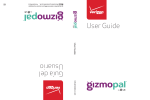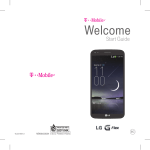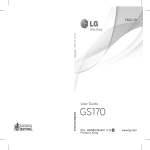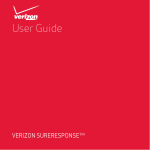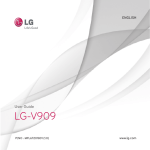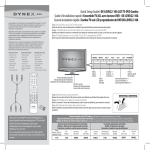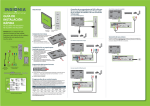Download LG VL600 Safety & Warranty
Transcript
P/N: MHK63291501 (1.0) H Product Safety and Warranty Information This booklet is made from 60% post-consumer recycled paper. This booklet is printed with soy ink. Printed in Korea. VL600 Violation of the instructions may cause serious injury or death. ● Never store your USB device in temperatures less than -4°F or greater than 122°F. ● Do not dispose of your device near fire or with hazardous or flammable materials. ● Do not use the USB Device in areas where its use is prohibited. (For example: aircraft) ● Do not expose the device to direct sunlight or use it in places with high humidity, such as a bathroom. ● Do not use harsh chemicals (such as alcohol, benzene, thinners, etc.) or detergents to clean your USB device. ● Do not drop, strike, or shake your USB device severely. It may harm the internal circuit boards of the USB Device. ● Do not use your USB device in high explosive areas as the USB Device may generate sparks. 1 2 ● Do not damage the device by bending, twisting, pulling, or heating. ● Do not place any heavy items on the device. ● Do not handle the USB Device with wet hands, while it is inserted into a USB port. ● Do not disassemble the USB Device. ● Do not hold or let the antenna come in contact with your body during use. ● Store the device out of reach of children. ● Be careful that children do not swallow the device. This could cause asphyxiation or suffocation resulting in serious injury or death. ● Only authorized personnel should service the USB Device and its accessories. Faulty installation or service may result in accidents and consequently invalidate the warranty. Body-worn Operation Part 15.19 statement This Mobile Broadband USB Modem, model VL600, is approved for use in normal size laptop computers only (typically with 12”or larger display screens). To comply with FCC RF exposure requirements, this modem should not be used in configurations that cannot maintain at least 5mm (approximately 0.2 inches) from your body. Also, when using the USB extension cable with a clip, place the USB modem with a clip away from your body or any other transmitter of the laptop or PC. This USB modem has been tested for compliance with FCC/IC RF exposure limits in the laptop computers configurations with horizontal and vertical USB slots and can be used in laptop computers with substantially similar physical dimensions, construction and electrical and RF characteristics. When using this USB modem in your computer, it must not be co-located or simultaneously transmit with any other radio (for example, Bluetooth or WiFi radios) in the computer. This device and its accessories comply with part15 of FCC rules. Operation is subject to the following two conditions: (1) This device & its accessories may not cause harmful interference. (2) This device & its accessories must accept any interference received, including interference that may cause undesired operation. Part 15.21 statement Change or Modifications that are not expressly approved by the manufacturer could void the user’s authority to operate the equipment. Part 15.105 statement This equipment has been tested and found to comply with the limits for a class B digital device, pursuant to Part 15 of the FCC Rules. These limits are designed to provide reasonable protection against harmful interference in a residential installation. This equipment generates uses and can radiate radio frequency energy and, if not installed and used in accordance with the instructions, may cause harmful interference to radio communications. However, there is no guarantee that interference will not occur in a particular installation. 3 If this equipment does cause harmful interference or television reception, which can be determined by turning the equipment off and on, the user is encouraged to try to correct the interference by one or more of the following measures: - Reorient or relocate the receiving antenna. - Increase the separation between the equipment and receiver. - Connect the equipment into an outlet on a circuit different from that to which the receiver is connected. - Consult the dealer or an experienced radio/TV technician for help. FCC RF Exposure Information WARNING! Read this information before operating the USB Device. In August 1996, the Federal Communications Commission (FCC) of the United States, with its action in Report and Order FCC 96-326, adopted an updated safety standard for human exposure to Radio Frequency (RF) electromagnetic energy emitted by FCC regulated transmitters. Those guidelines are consistent with the safety standard previously set by both U.S. and international standards bodies. The design of this USB device complies with the FCC guidelines and these international standards. 4 Vehicle-Mounted External Antenna (Optional, if available.) To satisfy FCC RF exposure requirements, keep 8 inches (20 cm) between the user / bystander and vehicle-mounted external antenna. For more information about RF exposure, visit the FCC website at www.fcc.gov. Caution Use only the supplied antenna. Use of unauthorized antennas (or modifications to the antenna) could impair connection quality, damage the USB Device, void your warranty and/or violate FCC regulations. Don't use the USB Device with a damaged antenna. A damaged antenna could cause a minor skin burn. Contact your local dealer for a replacement antenna. Consumer Information About Radio Frequency Emissions Your USB Device, which contains a radio transmitter and receiver, emits radio frequency energy during use. The following consumer information addresses commonly asked questions about the health effects of USB Devices. Are USB Devices safe? Scientific research on the subject of USB Devices and radio frequency (“RF”) energy has been conducted worldwide for many years, and continues. In the United States, the Food and Drug Administration (“FDA”) and the Federal Communications Commission (“FCC”) set policies and procedures for USB Devices. The FDA issued a website publication on health issues related to USB Device usage where it states, “The scientific community at large … believes that the weight of scientific evidence does not show an association between exposure to radiofrequency (RF) from cell phones and adverse health outcomes. Still the scientific community does recommend conducting additional research to address gaps in knowledge. That research is being conducted around the world and FDA continues to monitor developments in this field. You can access the joint FDA/FCC website at http://www.fda.gov (under “c” in the subject index, select USB Devices > Research). You can also contact the FDA toll-free at (888) 463-6332 or (888) INFO-FDA. In June 2000, the FDA entered into a cooperative research and development agreement through which additional scientific research is being conducted. The FCC issued its own website publication stating that “there is no scientific evidence that proves that wireless phone usage can lead to cancer or a variety of other problems, including headaches, dizziness or memory loss.” This publication is available at http://www.fcc.gov/cgb/cellular.html or through the FCC at (888) 225-5322 or (888) CALL-FCC. What does “SAR” mean? In 1996, the FCC, working with the FDA, the U.S. Environmental Protection Agency, and other agencies, established RF exposure safety guidelines for USB Devices in the United States. Before a USB Device model is available for sale to the public, it must be tested by the manufacturer and certified to the FCC that it does not exceed limits established by the FCC. One of these limits is expressed as a Specific Absorption Rate, or “SAR.” SAR is a measure of the rate of absorption of RF energy in the body. Tests for SAR are conducted with the USB Device transmitting at its highest power level in all tested frequency bands. Since 1996, the FCC has required that the SAR of handheld USB Devices not exceed 1.6 watts per kilogram, averaged over one gram of tissue. Although the SAR is determined at the highest power level, the actual SAR value of a USB Device while operating can be less 5 than the reported SAR value. This is because the SAR value may vary from call to call, depending on factors such as proximity to a cell site, the proximity of the USB Device to the body while in use, and the use of hands-free devices. For more information about SARs, see the FCC’s OET Bulletins 56 and 65 at http://www.fcc.gov/Bureaus/Engineering_Technology/Docume nts/bulletins or visit the Cellular Telecommunications Industry Association website at http://www.ctia.org/consumer_info/index.cfm/AID/10371. You may also wish to contact the manufacturer of your USB device. Can I minimize my RF exposure? If you are concerned about RF, there are several simple steps you can take to minimize your RF exposure. You can, of course, reduce your talk time. You can place more distance between your body and the source of the RF, as the exposure level drops off dramatically with distance. USB Devices marketed in the U.S. are required to meet safety requirements regardless of whether they are used against the head or against the body. Either configuration should result in compliance with the safety limit. You should also read and follow your USB Device manufacturer’s instructions for the safe operation of your USB device. 6 Do USB Devices pose any special risks to children? The FDA/FCC website states that “the scientific evidence does not show a danger to users of wireless communication devices, including children.” The FDA/FCC website further states that “some groups sponsored by other national governments have advised that children be discouraged from using USB Devices at all”. For example, the Stewart Report from the United Kingdom [“UK”] made such a recommendation in December 2000. In this report a group of independent experts noted that no evidence exists that using a USB Device causes brain tumors or other ill effects. [The UK’s] recommendation to limit USB Device use by children was strictly precautionary; it was not based on scientific evidence that any health hazard exists. A copy of the UK’s leaflet is available at http://www.dh.gov.uk (search “mobile”), or you can write to: NRPB, Chilton, Didcot, Oxon OX11 ORQ, United Kingdom. Copies of the UK’s annual reports on mobile USB Devices and RF are available online at www.iegmp.org.uk and http://www.hpa.org.uk/radiation/ (search “mobile”). Parents who wish to reduce their children’s RF exposure may choose to restrict their children’s USB Device use. Where can I get further information about RF emissions? For further information, see the following additional resources (websites current as of April 2005): U.S. Food and Drug Administration FDA Consumer magazine November-December 2000 Telephone: (888) INFO-FDA http://www.fda.gov (Under “c”in the subject index, select Cell Phones > Research.) U.S. Federal Communications Commission 445 12th Street, S.W. Washington, D.C. 20554 Telephone: (888) 225-5322 http://www.fcc.gov/oet/rfsafety Independent Expert Group on Mobile Phones http://www.iegmp.org.uk Royal Society of Canada Expert Panels on Potential Health Risks of Radio Frequency Fields from Wireless Telecommunication Devices 283 Sparks Street Ottawa, Ontario K1R 7X9 Canada Telephone: (613) 991-6990 http://www.rsc.ca/index.php?page=Expert_Panels_RF&Lan g_id=120 World Health Organization Avenue Appia 20 1211 Geneva 27 Switzerland Telephone: 011 41 22 791 21 11 http://www.who.int/mediacentre/factsheets/fs193/en/ International Commission on Non-Ionizing Radiation Protection c/o Bundesamt fur Strahlenschutz Ingolstaedter Landstr. 1 85764 Oberschleissheim Germany Telephone: 011 49 1888 333 2156 http://www.icnirp.de American National Standards Institute 1819 L Street, N.W., 6th Floor Washington, D.C. 20036 Telephone: (202) 293-8020 http://www.ansi.org National Council on Radiation Protection and Measurements 7910 Woodmont Avenue, Suite 800 Bethesda, MD 20814-3095 Telephone: (301) 657-2652 http://www.ncrponline.org 7 Engineering in Medicine and Biology Society, Committee on Man and Radiation (COMAR) of the Institute of Electrical and Electronics Engineers http://ewh.ieee.org/soc/embs/comar/ Consumer Information on SAR (Specific Absorption Rate) This model USB Device meets the government's requirements for exposure to radio waves. Your USB Device is a radio transmitter and receiver. It is designed and manufactured not to exceed the emission limits for exposure to Radio Frequency (RF) energy set by the Federal Communications Commission of the U.S. Government. These limits are part of comprehensive guidelines and establish permitted levels of RF energy for the general population. The guidelines are based on standards that were developed by independent scientific organizations through periodic and thorough evaluation of scientific studies. The standards include a substantial safety margin designed to assure the safety of all persons, regardless of age and health. The exposure standard for USB Devices employs a unit of measurement known as the Specific Absorption Rate, or SAR. The SAR limit set by the FCC is 1.6 W/kg. Tests for SAR are conducted using standard operating positions specified by the FCC with the USB Device transmitting at its highest certified power level in all tested frequency bands. Although SAR is 8 determined at the highest certified power level, the actual SAR level of the USB Device while operating can be well below the maximum value. Because the USB Device is designed to operate at multiple power levels to use only the power required to reach the network, in general, the closer you are to a wireless base station antenna, the lower the power output. Before a USB device model is available for sale to the public, it must be tested and certified to the FCC that it does not exceed the limit established by the government-adopted requirement for safe exposure. The tests are performed in positions and locations (e.g., at the ear and worn on the body) as required by the FCC for each model. The highest SAR value for this model USB Device when worn on the body, as described in this user guide, is 1.34 W/kg (body-worn measurements differ among USB device models, depending upon available accessories and FCC requirements). While there may be differences between SAR levels of various USB Devices and at various positions, they all meet the government requirement for safe exposure. The FCC has granted an Equipment Authorization for this model USB Device with all reported SAR levels evaluated as in compliance with the FCC RF emission guidelines. SAR information on this model USB Device is on file with the FCC and can be found under the Display Grant section of http://www.fcc.gov/oet/fccid after searching on FCC ID BEJVL600. Additional information on Specific Absorption Rates (SAR) can be found on the Cellular Telecommunications Industry Association (CTIA) website at http://www.ctia.org/. * In the United States and Canada, the SAR limit for mobile USB devices used by the public is 1.6 watts/kg (W/kg) averaged over one gram of tissue. The standard incorporates a substantial margin of safety to give additional protection for the public and to account for any variations in measurements. TIA Safety Information The following is the complete TIA Safety Information for wireless handheld USB devices. Exposure to Radio Frequency Signal Your wireless handheld portable USB device is a low power radio transmitter and receiver. When ON, it receives and sends out Radio Frequency (RF) signals. In August, 1996, the Federal Communications Commissions (FCC) adopted RF exposure guidelines with safety levels for handheld USB Devices. Those guidelines are consistent with the safety standards previously set by both U.S. and international standards bodies: ANSI C95.1 (1992) * NCRP Report 86 (1986) ICNIRP (1996) * American National Standards Institute; National Council on Radiation Protection and Measurements; International Commission on Non-Ionizing Radiation Protection Those standards were based on comprehensive and periodic evaluations of the relevant scientific literature. For example, over 120 scientists, engineers, and physicians from universities, government health agencies, and industry reviewed the available body of research to develop the ANSI Standard (C95.1). The design of your USB device complies with the FCC guidelines (and those standards). Antenna Care Use only the supplied or an approved replacement antenna. Unauthorized antennas, modifications, or attachments could damage the USB Device and may violate FCC regulations. Tips on Efficient Operation For your USB device to operate most efficiently: Don’t touch the antenna unnecessarily when the USB Device is in use. Contact with the antenna affects call quality and may cause the USB Device to operate at a higher power level than otherwise needed. 9 Electronic Devices Other Medical Devices Most modern electronic equipment is shielded from RF signals. However, certain electronic equipment may not be shielded against the RF signals from your USB Device. If you use any other personal medical device, consult the manufacturer of your device to determine if it is adequately shielded from external RF energy. Your physician may be able to assist you in obtaining this information. Pacemakers The Health Industry Manufacturers Association recommends that a minimum separation of six (6) inches be maintained between a handheld USB Device and a pacemaker to avoid potential interference with the pacemaker. These recommendations are consistent with the independent research by and recommendations of Wireless Technology Research. Persons with pacemakers: ● Should ALWAYS keep the USB Device more than six (6) inches from their pacemaker when the USB Device is turned ON; ● Should not carry the USB Device in a breast pocket; ● Should use the ear opposite the pacemaker to minimize the potential for interference; ● Should turn the USB Device OFF immediately if there is any reason to suspect that interference is taking place. Health Care Facilities Turn your USB device OFF in health care facilities when any regulations posted in these areas instruct you to do so. Hospitals or health care facilities may use equipment that could be sensitive to external RF energy. Vehicles RF signals may affect improperly installed or inadequately shielded electronic systems in motor vehicles. Check with the manufacturer or its representative regarding your vehicle. You should also consult the manufacturer of any equipment that has been added to your vehicle. Posted Facilities Turn your USB Device OFF in any facility where posted notices so require. Aircraft FCC regulations prohibit using your USB Device while in the air. Switch OFF your USB Device before boarding an aircraft. 10 Blasting Areas To avoid interfering with blasting operations, turn your USB Device OFF when in a “blasting area”or in areas posted: “Turn off two-way radio”. Obey all signs and instructions. Safety Information Please read and observe the following information for safe and proper use of your USB Device and to prevent damage. Caution Potentially Explosive Atmosphere Turn your USB Device OFF when in any area with a potentially explosive atmosphere and obey all signs and instructions. Areas with a potentially explosive atmosphere are often, but not always marked clearly. Potential areas may include: fueling areas (such as gasoline stations); below deck on boats; fuel or chemical transfer or storage facilities; vehicles using liquefied petroleum gas (such as propane or butane); areas where the air contains chemicals or particles (such as grain, dust, or metal powders); and any other area where you would normally be advised to turn off your vehicle engine. Violation of the instructions may cause minor or serious damage to the product. ● ● ● ● ● For Vehicles Equipped with an Air Bag ● An air bag inflates with great force. DO NOT place objects, including either installed or portable wireless equipment, in the area over the air bag or in the air bag deployment area. If in-vehicle wireless equipment is improperly installed and the air bag inflates, serious injury could result. ● ● Do not disassemble or open crush, bend or deform, puncture or shred. Do not modify or remanufacture, attempt to insert foreign objects into the device, immerse or expose to water or other liquids, expose to other hazard. Only use the device for the system for which it is specified. Promptly dispose of used devices in accordance with local regulations. Device usage by children should be supervised. Avoid dropping the USB Device or exposing the USB Device to a liquid. If the USB Device is dropped, especially on a hard surface, or is exposed to a liquid or comes into contact with a sharp object take it to a service center for inspection. At least, one of the Authentication methods may be implemented. (e.g. H/W, S/W, Mechanical, Hologram, etc.) Improper use of the device may result in a other hazard. 11 Information and Care Shock, and other Hazards ● ● Do not put your USB Device in a place subject to excessive dust and keep the minimum required distance between the power cord and heat sources. ● If you put your USB Device in a pocket or bag without covering the receptacle of the USB Device (power plug pin), metallic articles (such as a coin, paperclip or pen) may short-circuit the USB Device. Always cover the receptacle when not in use. ● ● ● ● ● ● ● ● 12 Please read the manual of proper installation and removal of the device. Do not damage the device by bending, twisting, or heating. Do not place any heavy items on the device. Always cover the receptacle when not in use. Never store your USB Device in temperature less than -4°F or greater than 122°F. Do not use or leave the device under the blazing sun or in heated car by sunshine. The device may generate heat, smoke or flame. And also, it might cause the deterioration of device’s characteristics or cycle life. General Notice ● Using a damaged device or placing a device in your mouth or animal's mouth may cause serious injury. When the device has rust, bad smell or something abnormal at first-time-using, do not use the equipment and go to bring the device to the shop which it was bought. ● Do not place items containing magnetic components such as a credit card, phone card, bank book, or subway ticket near your USB Device. The magnetism of the USB Device may damage the data stored in the magnetic strip. In case younger children use the device, their parents should teach them how to use the device according to the manual with care. ● When the USB Device is not used for a long period of time, store it in a safe place. ● Do not use the USB Device if the antenna is damaged. If a damaged antenna contacts skin, it may cause a slight burn. Please contact an LG Authorized Service Center to replace the damaged antenna. Do not handle the USB Device with wet hands. Do not use harsh chemicals (such as alcohol, benzene, thinners, etc.) or detergents to clean your USB Device. ● Using the device in close proximity to receiving equipment (i.e.tv or radio) may cause interference to the device. ● Do not immerse your USB Device in water, liquid, or expose to high humidity. If this happens, turn it off immediately and remove the device. Immediately, take it to an LG Authorized Service Center. ● Do not paint your USB Device. Limited Warranty Statement 1. WHAT THIS WARRANTY COVERS: LG offers you a limited warranty that the enclosed device and its enclosed accessories, if any, will be free from defects in material and workmanship, according to the following terms and conditions: (1) The limited warranty for the product extends for TWELVE (12) MONTHS beginning on the date of purchase of the product with valid proof of purchase, or absent valid proof of purchase, FIFTEEN (15) MONTHS from date of manufacture as determined by the unit's manufacture date code. (2) The limited warranty extends only to the original purchaser of the product and is not assignable or transferable to any subsequent purchaser/end user. (3) This warranty is good only to the original purchaser of the product during the warranty period as long as it is in the U.S., including Alaska, Hawaii, U.S. Territories and Canada. (4) The external housing and cosmetic parts shall be free of defects at the time of shipment and, therefore, shall not be covered under these limited warranty terms. 13 (5) Upon request from LG, the consumer must provide information to reasonably prove the date of purchase. (5) Products which have had the serial number removed or made illegible. (6) The customer shall bear the cost of shipping the product to the Customer Service Department of LG. LG shall bear the cost of shipping the product back to the consumer after the completion of service under this limited warranty. (6) This limited warranty is in lieu of all other warranties, express or implied either in fact or by operations of law, statutory or otherwise, including, but not limited to any implied warranty of marketability or fitness for a particular use. 2. WHAT THIS WARRANTY DOES NOT COVER: (1) Defects or damages resulting from use of the product in other than its normal and customary manner. (2) Defects or damages from abnormal use, abnormal conditions, improper storage, exposure to moisture or dampness, unauthorized modifications, unauthorized connections, unauthorized repair, misuse, neglect, abuse, accident, alteration, improper installation, or other acts which are not the fault of LG, including damage caused by shipping, blown fuses, spills of food or liquid. (3) Breakage or damage to antennas unless caused directly by defects in material or workmanship. (4) That the Customer Service Department at LG was not notified by consumer of the alleged defect or malfunction of the product during the applicable limited warranty period. 14 (7) Damage resulting from use of non LG approved accessories. (8) All plastic surfaces and all other externally exposed parts that are scratched or damaged due to normal customer use. (9) Products operated outside published maximum ratings. (10) Products used or obtained in a rental program. (11) Consumables (such as fuses). 3. WHAT LG WILL DO: LG will, at its sole option, either repair, replace or refund the purchase price of any unit that is covered under this limited warranty. LG may choose at its option to use functionally equivalent re-conditioned, refurbished or new units or parts or any units. In addition, LG will not re-install or back-up any data, applications or software that you have added to your USB Device. It is therefore recommended that you back-up any such data or information prior to sending the unit to LG to avoid the permanent loss of such information. 4. STATE LAW RIGHTS: No other express warranty is applicable to this product. THE DURATION OF ANY IMPLIED WARRANTIES, INCLUDING THE IMPLIED WARRANTY OF MARKETABILITY, IS LIMITED TO THE DURATION OF THE EXPRESS WARRANTY HEREIN. LG SHALL NOT BE LIABLE FOR THE LOSS OF THE USE OF THE PRODUCT, INCONVENIENCE, LOSS OR ANY OTHER DAMAGES, DIRECT OR CONSEQUENTIAL, ARISING OUT OF THE USE OF, OR INABILITY TO USE, THIS PRODUCT OR FOR ANY BREACH OF ANY EXPRESS OR IMPLIED WARRANTY, INCLUDING THE IMPLIED WARRANTY OF MARKETABILITY APPLICABLE TO THIS PRODUCT. Some states do not allow the exclusive limitation of incidental or consequential damages or limitations on how long an implied warranty lasts; so these limitations or exclusions may not apply to you. This warranty gives you specific legal rights and you may also have other rights which vary from state to state. DO NOT RETURN YOUR PRODUCT TO THE ABOVE ADDRESS. Please call or write for the location of the LG authorized service center nearest you and for the procedures for obtaining warranty claims. 5. HOW TO GET WARRANTY SERVICE: To obtain warranty service, please call or fax to the following USB Device numbers from anywhere in the continental United States: Tel. 1-800-793-8896 or Fax. 1-800-448-4026 Or visit http://us.lgservice.com. Correspondence may also be mailed to: LG Electronics Service- Mobile Handsets, P.O. Box 240007, Huntsville, AL 35824 15 P/N: MHK63291501 (1.0) H Product Safety and Warranty Information This booklet is made from 60% post-consumer recycled paper. This booklet is printed with soy ink. Printed in Korea. VL600


















